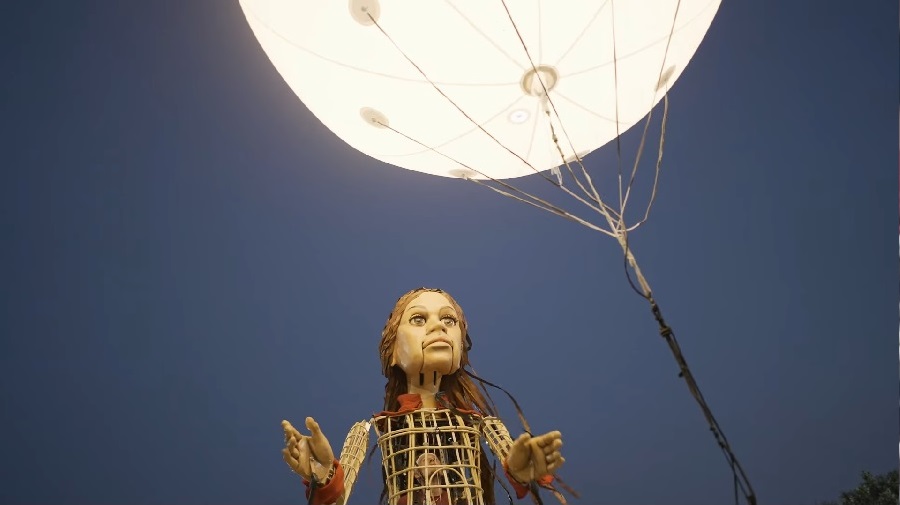The Walk, a traveling festival of art surrounding the journey of Little Amal, a giant 12-foot puppet, began in July 2021 at the Turkey/Syria border, and concluded in Manchester, England, last November. This bold public art project celebrating refugees, raising awareness, and sparking wonder, love, and excitement, was conceived and executed on a scale never attempted, and with shockingly little funding. Behind The Walk was a complex act of producing magic, performed by theatremakers collaborating across borders and cultures. As a U.S. partner of the project, I was fortunate to have conversations with many of the producers and organizers about their experiences, and was on hand to witness its closing steps.
It all began with David Lan, former artistic director of the Young Vic, who was wrestling with the question of action in the face of the worsening migrant crisis in Europe. “How does one respond?” he recalled wondering. “What does one do besides donate money?” It started as a simple idea: “I should walk.”
He pictured himself walking a route like that of the Syrian refugees, talking with people along the way and posting on social media. He credits a friend, the director Stephen Daldry, whom he called “the great enabler,” with refining the vision, insisting that it be “theatre.” The idea of the walking remained, but it would be centered around a giant puppet, one “too big to ignore.” The thinking behind the project was distilled into a simple message: “Don’t forget about us.”
Daldry suggested that Lan meet with Tracey Seaward (she/her), a film producer largely credited for the success of the London Olympics Opening Ceremony in 2012. Seaward, who has lots of experience producing on location in other countries, and a special appreciation for the empathetic nature of puppets, was immediately hooked. Together they approached Adrian Kohler and Basil Jones of Handspring Puppet Company, based in South Africa. Said Seaward, “Adrian’s specialty is making incredibly expressive faces.” The puppet had to be vulnerable and capable of expressing a wide range of emotions despite her commanding size. Kohler and Jones immediately got it; one of Kohler’s first questions was, “How does she dream?”
Daldry also connected them to Good Chance Theatre, with whom he had collaborated in the making The Jungle, created with migrants in the Calais refugee camp. It was a natural alignment of what was now being called The Walk with a nonprofit institution. Somewhere along the way, the puppet acquired the name “Amal,” inspired by a 9-year-old unaccompanied minor character who appeared briefly in The Jungle.
This in turn raised the questions: Whose story was this? And who had the right to tell it?
Enter Amir Nizar Zuabi (he/him), who became the project’s artistic director in 2019. A long-time associate of Lan’s, Zuabi is a visionary and critically acclaimed director. He is also the child of refugees on both sides of his Palestinian/Jewish heritage, making him the appropriate person to control the story. This sensitivity extended to assembling the rest of the company, as extraordinary artists, technicians, and documentary filmmakers were hired from a wide range of countries and cultural backgrounds.
Everyone involved in The Walk credits Zuabi’s artistic vision and leadership for the project’s success. He defined the narrative, giving Amal a specific story: She was searching for her mother. He also understood the importance of making room for spontaneous, unpredictable audience interactions within these curated “acts of welcome.” And he worked intimately with each regional producer to create and define the more than 140 events that took place over four months and 5,000 miles.
Each regional producer developed a relationship with Zuabi during the pandemic over Zoom, spending hours every week plotting the route and brainstorming events. The overwhelming mandate was to create work of the highest artistic quality, to search for moments that would astonish, and to make a huge impact. All involved had to balance the sometimes competing ambitions of the project: to be authentic, to connect in an honest and meaningful way with different refugee communities along the route, to collaborate with the partners at each location, and to honor Zuabi’s insistence that they create something that hadn’t been seen before. They had to discover, Zuabi said, “How does she turn the sky red?,” i.e., how Amal’s presence could somehow change the landscape in any given place. They also had to be as true as possible to the experience and perspective of a 9-year-old girl; they could never ask Amal to do something or participate in an event that wouldn’t make sense from the character’s point of view.
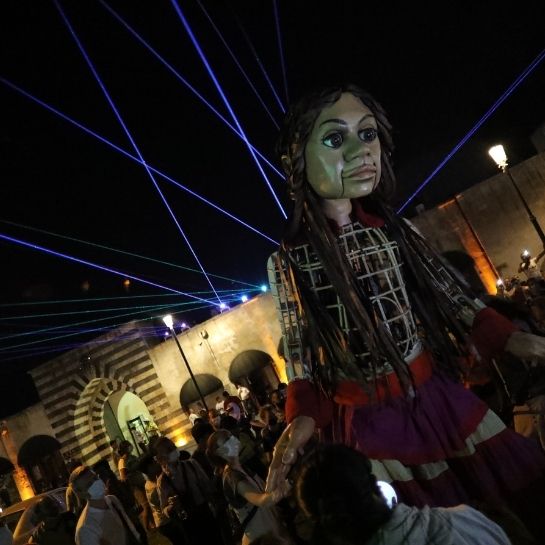
In mapping the route, the producers considered the symbolic importance of each location. In some cases, there were existing relationships with local organizations, and in others these had to be constructed. The events comprised large-scale open-air spectacles, intimate gatherings, and everything in between. Some events were highly conceptual—like a nightmare sequence of video projections in Rome—and some were simple appearances in highly symbolic or very ordinary places.
Zuabi felt grounded after he conceived a few key moments: thousands of shoes on the shores of Çeşme, a Turkish resort town, for example. When he envisioned a flock of birds forming the image of Amal’s mother in the sky over Manchester, he had his ending: She wouldn’t find her mother, but rather receive a sign that she had landed in the place she was meant to be. The birds connected directly to the scene at the beginning of the journey, in Adana, Turkey, chosen by Nizar for its historic Taskoru bridge, which Amal would cross surrounded by wooden puppet birds, against the striking background of the town’s historic mosque. Crossing and building bridges were central metaphors of The Walk. With these anchors, Zuabi began to build Amal’s story in large, sweeping visual gestures.
Once the beginning and end of the route were chosen, each producer in their turn had to grapple with the question of where their respective Walk events would begin (and end). This would determine not only the design of each event but also the route itself. Would Amal walk from the center to the outskirts, as she did in Brussels, Belgium, where she started at La Monnaie Opera and led followers to the Abattoir in an immigrant enclave on the city’s periphery? Or would she enter from outside the center, as she did in Paris, starting in Department 93, one of the city’s poorest immigrant neighborhoods before visiting the Eiffel Tower?
In Turkey, producer Recep Tuna worked in partnership with iKSV (Istanbul Foundation for Culture and Arts) to produce the first leg of the journey. He met Lan and Seaward in 2018 on one of their reconnaissance trips in Izmir in 2018. He immediately loved the project but had concerns about their capacity to navigate the complex world of permissions and governmental bureaucracy in his region.
“Walking a giant puppet from Gaziantep to Izmir is not like walking a giant puppet in Paris,” Tuna said. Turkey, he pointed out, has no tradition of public procession around a puppet. (There is a long history of shadow puppetry in many forms throughout the region, but this was something entirely new.) And help would be needed at every governmental level, all the way up to the Ministry of Culture.
Tuna joined the project in March 2020 and began to raise funds, as the agreement with each regional producer was they that would find the resources for the events in their territory. There were exceptions, when The Walk producers provided additional money to enable a specific Big Art event, like the massive video mapping and projections in Rome. Tuna’s initial approaches to the usual government-sponsored institutions were unsuccessful, as the Turkish economy was hurting. Tuna soon discovered that more support lay in local municipalities, with the mayors, who are directly elected by the community. The mayor of Izmir, for instance, procured accommodations for all 34 company members for five nights, and Adana’s mayor contributed equipment needed for a concert.
Tuna recalled his amazement at the first event in Gaziantep. They had worked with many local refugee groups to organize kids in groups with lanterns stationed along the route; as Amal passed, each group folded into the stream of light accompanying her. The sheer quantity of lanterns that materialized exceeded his expectations.
“It was a flow of light and kids enjoying themselves, and all these refugee families living for these years in Gaziantep, most likely for the first time enjoying themselves living in this city, in this capacity,” he marveled.
Although the U.K. producers worried about security in Turkey, Zuabi did not. He was confident that they would be embraced warmly by the crowds. Even so, security in Turkey is tightly controlled; though the permits were filed in advance, someone from the company had to appear in each local municipality the day before the event to receive final permissions for both film production and public assembly. In this region, it is harder to go rogue, to go off-script and improvise, an essential ingredient of Zuabi’s aesthetic.
This took some nimble adjustments. The rule with the company in the streets was for the puppeteers to follow Zuabi: If he walked down an alley, they would follow. Tuna was preoccupied with security, and was comforted by having uniformed police and plain-clothed security forces on hand. Zuabi wanted to make sure there were no barriers between Amal and the crowds. Eventually security relaxed.
Keeping Turkish authorities on board for the project required some careful diplomacy. Though Turkey has taken in more than 3.5 million refugees—more than all of Europe combined, twice over—Tuna noticed a change in official attitudes. While initially, the government favored a project in support of refugees and their humanitarian efforts, but when the U.S. began to withdraw troops from Afghanistan, and Afghani migrants, mostly men, started to enter from the mountains bordering Iran, popular Turksih sentiment shifted.
But The Walk progressed in any case, with the only real obstacle in Turkey being fires that raged through July and August, which necessitated some rerouting. One visit to a nomadic settlement was canceled because residents had been called to help fight the fires. They rescheduled another event at the last minute due to an unexpected
intervention by local academics who connected Tuna with a nearby village which still upholds ancient nomadic ways. These kinds of miracles were another defining feature of producing The Walk; Zuabi says they happened daily. Each producer can recount many such serendipities.
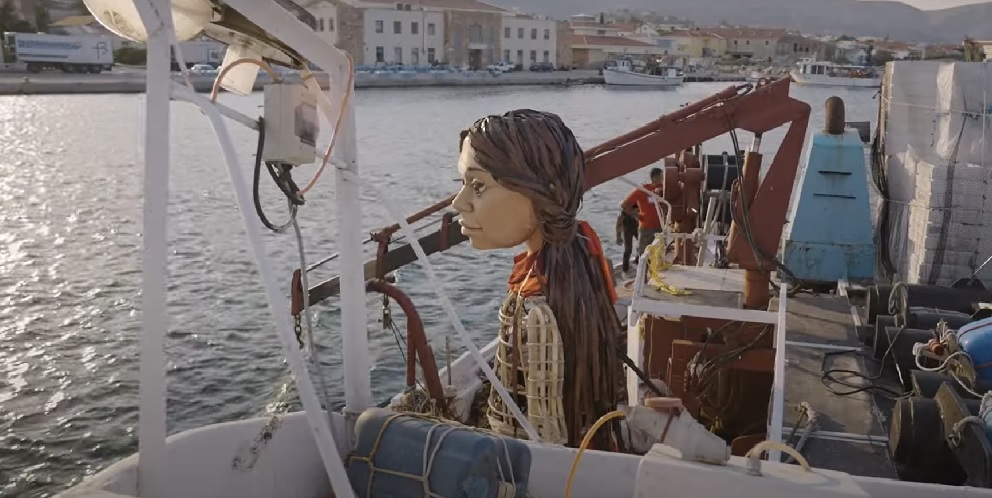
One of the most improbable happened in Greece. For Amal’s entrance into Greece via Chios on a boat, escorted by the Chios Philharmonic Orchestra, producer Yolanda Markopoulou (she/her) had hoped the border would finally be opened after months of COVID shutdown; that would not happen until a week after the event, so the company had to fly from Istanbul, a 15-hour journey, rather than the 90-minute trip it would be via boat. Then, even once she got the artists there, there was another setback: With fires also raging in Greece, the port police refused to allow the use of any of the boats for the Amal events, as they were being requisitioned to fight the fires. Everyone in the municipalities who might have been able to help them was completely distracted by the national emergency.
Markopoulou met Zuabi in person for the first time, and explained that she had to find a way to make it happen. She reached out to a local filmmaker friend who knew a fisherman; he hadn’t seen him in years, wasn’t sure how to contact him, and doubted she could reach him to secure his boat for the following day. Undeterred, the next morning she went to the port with a bathing suit, prepared to swim out to boats in the port if necessary. She saw two appropriately sized boats at the docks, inquired of the crews about the owner—and was overjoyed to hear them give them the name of the fisherman her friend had mentioned. The boats were scheduled for night fishing at 7 p.m.; Amal’s event was scheduled for 6 p.m. After a phone call to the fisherman and a hasty meeting, Markopoulou had secured the boats.
For her it was more than a logistical victory; it was an intensively emotional moment. This event in Chios was dedicated to kids who had drowned in this crossing, and she felt a profound commitment to honor their ill-fated journeys. Amal couldn’t just walk into town; her entrance had to be true to how refugees enter Greece, where those who don’t drown arrive on boats.
Another major challenge in Greece came when agitators in the town of Larissa threw food and stones at Amal. Though the producers completed their walk and did not disappoint the people in Larissa, who had been preparing for weeks to receive Amal, in Athens, their event was cancelled because of serious threats to the company. So the producers decided to have Amal appear on a rooftop, from which she could be seen by the crowd. Zuabi was improvising, as was Markopoulou, who secured a private roof terrace on the fly.
Reflecting on the security challenges, Markopoulou worried not only about the company’s immediate safety but about whether they would be a domino effect with right-wing protesters in the subsequent countries. Engaging with the press coverage of negative crowd reactions became an unanticipated focus for her. But the truth is that what happened in Greece, including Amal’s later being barred from entering Meteora, were essential moments for the project. They reminded everyone about the reason for The Walk; the crisis, and the pushback, were real.
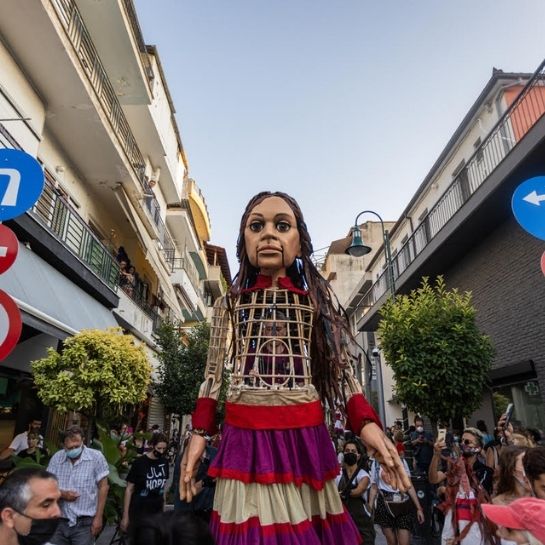
In Italy, security was less of a concern than COVID-19 and its traumatic toll on the population, which cast a long shadow over The Walk events. Many permits there had to be filed solely for “film production” and often had to promise not to attract crowds. Producers Roberto Roberto (he/him) and Ludovica Tinghi (she/her) described the experience of collaborating with The Walk as an immersion into a community of artists who all “smell the same scent of theatre.” They felt an immediate synchronization of theatrical instincts and values, they said, and understood how Zuabi worked: “very clear, very precise, and at the same time a little crazy.”
COVID concerns aside, the project was not a hard sell in Italy, a country with a huge cultural focus on children. With few exceptions, The Walk found eager partners there, including in poorer regions in the South, where producers were met with overwhelming generosity. In Puglia, the government donated 100,000 Euros to the cost of the events, which were managed by the Teatro Pugliese, coordinating dozens of community partners for events in Bari.
In Naples, no money was forthcoming, but hearts were huge and everyone turned out to do their part. The city was the site of another Big Art vision, “The Tantrums,” in which Amal has a tantrum. Inspired by the tantric-like music of Tammurriata, an early Naples dance form, Roberto and Tinghi had 110 drummers arrive from all around the region, some driving several hours, all volunteers.
The Walk also connected with La MaMa Umbria, the haven for artists created by legendary LaMaMa Theatre founder Ellen Stewart. To music from many traditions, dances were performed for Amal using large white puppet birds, and the company was hosted overnight by La MaMa Umbria artistic director David Diamond.
A meeting with Pope Francis was not arranged until two days before it happened, when Roberto and Tinghi received a top-secret call. This was one of the most emotional events for them, not only because of the enormous symbolic power of the meeting, but also because the Vatican had arranged for a group of children from around the world to interact with Amal in the courtyard beforehand. Recalled Roberto, “They were talking to Amal in a most authentic way,” expressing solidarity and kindness, and offering to take her into their homes. Eschewing pomp and circumstance, the Pope very simply wandered over to the group of children to gently welcome Amal.
The stop in Turin was a similarly quiet and gorgeous experience. They had planned shadow plays, and Roberto made sure the city lights cut off just before the event. Suddenly a huge rainstorm descended, and it was decided that Amal could not walk. They went to explain the situation to the refugee kids who had been preparing for weeks to meet Amal. A young Syrian girl came forward and said, “My name is Amal,” and asked if they would see Little Amal the next day. Zuabi explained that they’d be in San Remo the next day. “So we will never meet her?” she wondered. Zuabi made an impulsive decision: They brought Amal out in the dark; it was wet and dangerous, but miraculously the rain stopped just in time and they were able to walk—spontaneously, without permits, everyone taking a big risk. The producers’ tenacity and fearlessness in honor of the project’s mission was a consistent feature of The Walk.
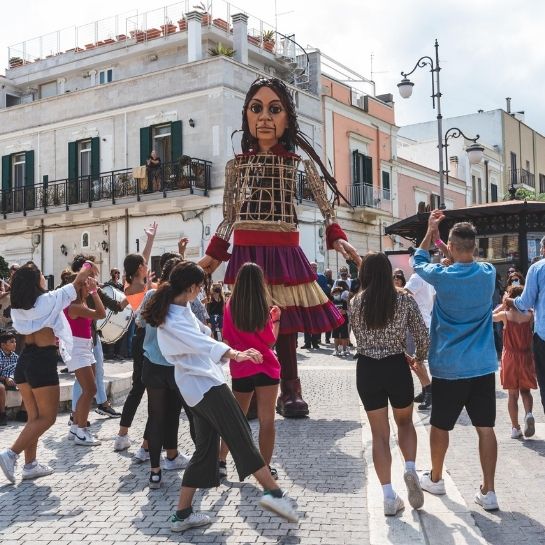
Claire Béjanin (she/her) was responsible for the largest region of The Walk: France, Germany, Switzerland and Belgium, 41 events in all. The co-founder of Good Chance France, a separate but affiliated organization, Béjanin was involved in the earliest stages of The Walk’s development, including an initial workshop in England in 2019.
The evolution of the routes through her complicated territory evolved out of constantly shifting scenarios, impacted by pandemic shutdowns, political sensitivities, and logistics. Briançon was always the desired place to cross into France, but the authorities would not allow it, so they made their way through Briel-Sur-Roya, a poor suburb of Nice which had suffered greatly from flooding the year before, and where consequently many were still homeless. It was less than ideal as a warm welcome, but they made do. Béjanin felt it was important to visit Briançon in some way, to connect with the volunteer associations providing aid to migrants, especially for the harsh winter climate so high in the mountains, so they created an event in Briançon before crossing into Germany.
She also faced challenges in the North. Just weeks before the final big event planned for Calais, the city’s mayor refused access to the beach. Béjanin raced northward, traveling around the coastal cities but facing similar rejection from right-wing local municipalities. At last she found a progressive mayor in Bray-Dunes, her last hope, who agreed to open their beach for the final event. The arrangement was so last-minute there was barely enough publicity, so the result was witnessed only by a few hundred on-lookers. But those who saw it won’t soon forget the spectacle: The region has its own tradition of giant puppets who appear during the annual carnival, and by most accounts, never had so many of them come together in one place, as they gathered on a mostly empty beach to meet Amal, serenaded by the opera singer, Joyce DiDonato, for what Béjanin described as a beautiful and emotional concert.
Béjanin produced several events from the ground up, working intimately with the lead artists and finding the funding to support them. When the Waves Have Come and Gone, created by Palestinian choreographer Samar Hadad King on the beach in Marseilles, was an important piece for her. An example of the Big Art concept meshing harmoniously with community engagement, it created something transcendent. Hadad worked for three weeks with scores of volunteers, as well as professional dancers, and dozens of life jackets, and a score by Kinan Azmeh that mixed music from many traditions to honor the lives of refugees lost at sea. The event attracted over 5,000 spectators. Béjanin notes that too frequently artists approach community projects on too small a scale. “Communities are thirsty for big things,” she insisted. “They are ready for it.”
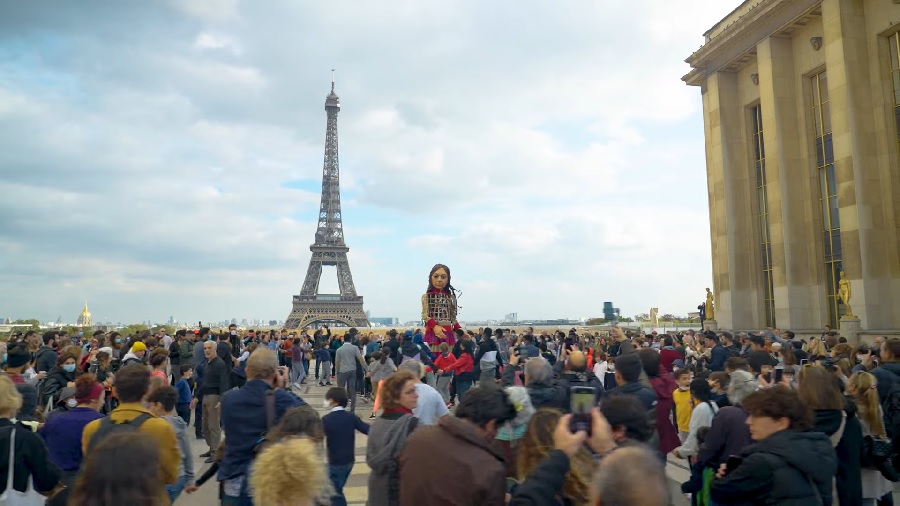
This sentiment was echoed forcefully by Amaya Jeyarajah Dent, the U.K. producer. “Don’t give me crocheting table mats with migrant women, because it’s been done 100 times,” she quipped. Creating something huge for refugees is a radical act, she explained, adding, “Putting on an incredible show for people to be part of, or come to see—this act in itself is changing the narrative.” Dent understood Zuabi’s desire for strong, simple visuals and “his incredibly ambitious art.”
An experienced producer of public events, Dent is accustomed to the unpredictability of working in public spaces. She discussed the process of building strong relationships in communities. At each location in the U.K., The Walk had one central partner, many of them in place before she was hired, because of strong ties to the U.K. producing team. Still, in some places, Dent built the event from the ground up, beginning with research and outreach to local arts organizations.
“It’s extremely conversational work,” she said, most of it done on Zoom. She attended community forums and met with everyone she could, to understand the “plethora of different priorities,” a process she said always fascinates her. “Everyone wants to feel valued and respected,” she said. “It’s about tapping into what makes any given group or person feel proud and connected.”
For example, while organizing the event in Folkestone with the art collective UV Labs—they created a large sculpture of scale models of wooden boats that would face the sea—she faced an unexpected problem. The Folkestone partners didn’t feel the sculpture was tonally appropriate, because migrants don’t arrive by boat on their beaches, but rather in nearby Dover. They felt this would perpetuate a false narrative constantly being aimed at Folkestone. Ultimately, they reconceived the event as a concert at an abandoned train station. It was the first U.K. interaction, and though rain and wind was expected, thousands showed up and the skies magically cleared. Producers were able to install a different sculpture in Dover, on the grounds of its historic lighthouse, in an unprecedented accommodation at one of the most visited tourist sites in Britain.
Although Dent is most proud of figuring out how to activate the most significant historical sites in central London, she also values having brought The Walk to rural places, like Barnsley, where they don’t typically get big international productions. The depth of the emotions that were stirred when first-generation kids in thick Yorkshire accents read poems for Amal took her by surprise. And that so many people came out in these locations meant more than such attendance did in the cities, because they had to come from much further distances. Dent believes this helped to change people’s relationships to their home region, saying, “It goes from being a place where nothing ever happens, to a place where that thing came here and it happened here.”
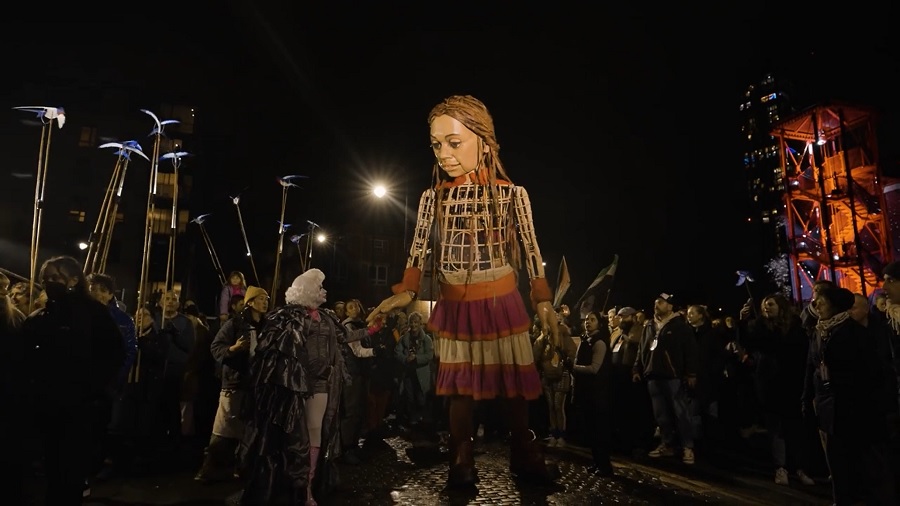
Because her territory was the last, Dent was able to do a lot of pre-production with Zuabi while he was in real-time production elsewhere. As The Walk progressed, each of the regional producers experienced the ebb and flow of communication with the core producing team, as well as with each other. Though the producers met together every few weeks before The Walk started, this was harder to do once they began. Each regional producer worked independently, but knew they could reach out to each other for support.
All the producers wanted to be with Zuabi in Manchester for the final events, Seaward noted. But the Turkish partners were not able to secure visas, and Markopoulou, who had been with them through London, had to return to Greece. For my part, I met Béjanin, Roberto, and Tinghi, as well as the U.K. producers, in these last days in north England and observed their closeness. They had formed life-changing relationships with each other during this massive collaboration. Seaward and Lan hailed Zuabi for his vision, ambition, and tenacity. Said Seaward, “It’s a credit to him that everyone wanted to be in the Recce (reconnaissance) van with him at the end. That says a lot.”
It does. So does the model created by these international producers, who realized a sprawling project, wrapped around a simple message. It was achieved through an incalculable number of small steps, as well as some seemingly divine intervention.
Alexandra Aron (she/her) is the producing artistic director of the Remote Theater Project, the only U.S. organization to have an interactive production with The Walk, via live-feed in August, at the beginning of the journey. Working with teen refugees and asylum seekers, Aron organized A Message From Far Away, a two-day festival in Portland, Me., that included Kinan Azmeh’s City Band, the Pihcintu Girls Chorus, and members of the Portland Symphony Orchestra. The production featured Little Amal projected in scale, on a large video wall, interacting in real-time from Ural, Turkey.

